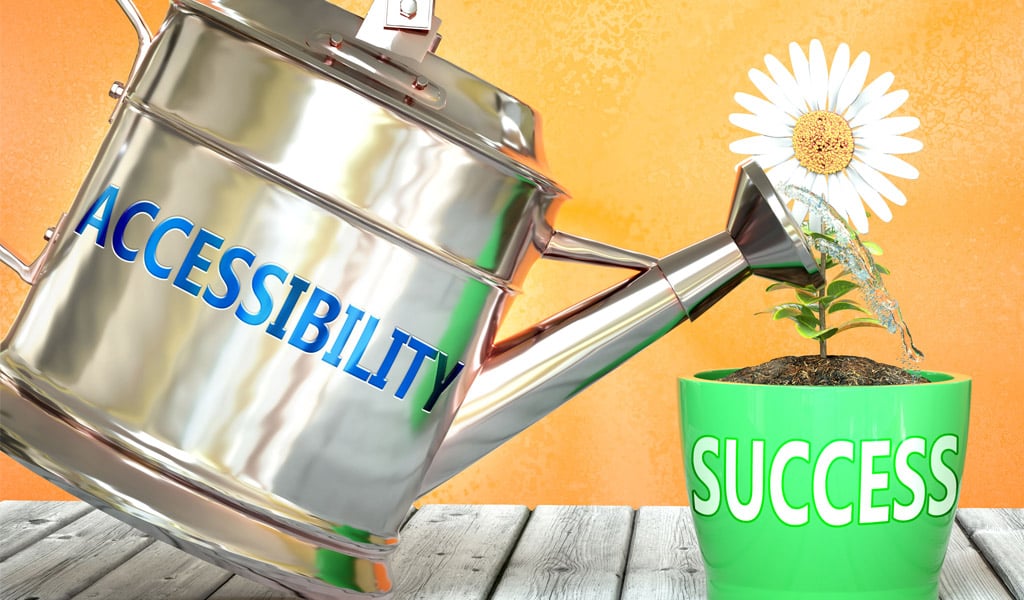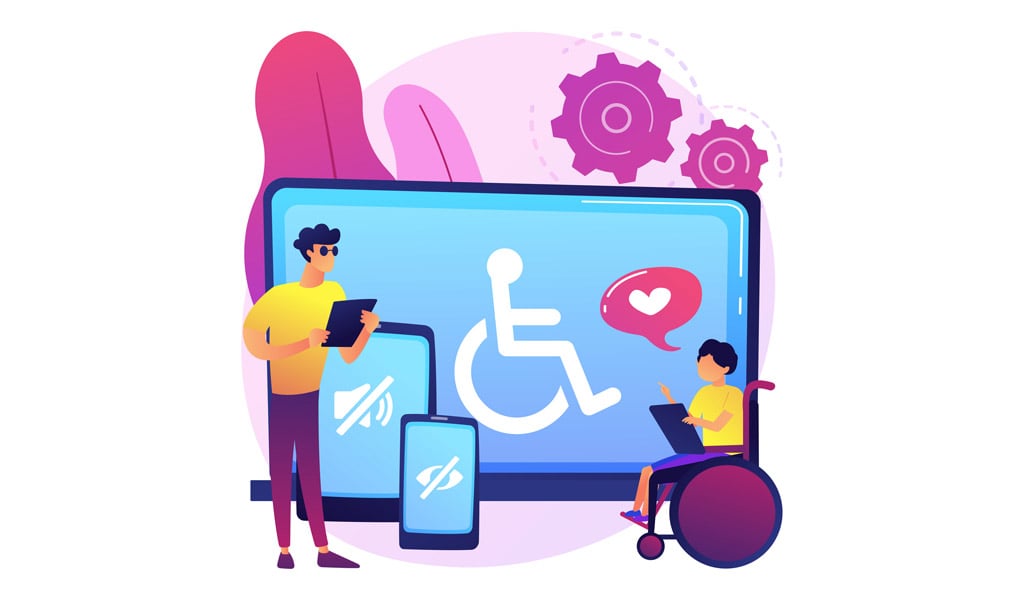
According to research by the World Health Organization, approximately 15% of the world’s population experiences some form of disability. Looking at other data from the CDC, this figure stands at 26% of adults in the US having some form of disability. This disability can be anything from hearing impairment, visual impairment, to movement disabilities. These users can often struggle to access your services and therefore have a poor experience. The breakdown from the CDC looks like this:
- Around 13.7% have a mobility disability (serious difficulty with walking or using stairs).
- Around 10.8% have a cognitive disability (trouble concentrating, decision making, or remembering).
- 5.9% have a hearing impairment.
- Around 4.6% are visually impaired.
- Around 10.5% have self-care or independent living difficulties.
Unfortunately, many businesses still don’t provide accessible customer service. Companies often ignore or fail to consider customers with disabilities when designing their customer service funnel. If you’re one of these businesses, then it’s time to change. Not only are you making life more difficult for your customers, but you’re always missing opportunities to boost your success. If your company gets a reputation for being highly accessible, you will attract more customers. Additionally, the more accessible your services are, the more approachable they are for everyone, not just people with disabilities. With this in mind, let’s take a look at how you can better serve your customers with disabilities.
What is Accessible Customer Service?
Accessible customer service is when you provide services that empower or enable individuals with disabilities to engage with your services. The decisions you make can have a significant impact.
Consider these statistics:
- 71% of users with disabilities will leave a website with low or no accessibility.
- Research into web and app accessibility lawsuits has shown some surprising findings. There’s been a sharp increase in the last four years, with over 2000 cases in 2019.
- 2.3% of people in the US have a visual disability. 6.6% of people over the age of 65 have a vision disability.
Domino’s Case Study
The popular pizza chain, Domino’s Pizza, lost a landmark case related to accessibility. A blind patron, Mr. Robles, said he struggled to change pizza toppings on the company’s app. He was unable to complete the purchase. The complainant took Domino’s to court in 2017, but the case was initially dropped. However, the plaintiff appealed and was successful in 2019.
For those who aren’t familiar with the Domino’s app and its Pizza Builder feature, it’s essential to know that the app is highly visual. The pizza builder feature is mostly made up of visual interactive elements and images. This is true for many websites, but most websites will tag and label visual elements so that blind people can use screen readers. According to Robles, both Domino’s app and website lack the required labeling. Reportedly, he also couldn’t take advantage of discounts.
In the US, companies have to adhere to the Americans With Disabilities Act of 1990. This act stipulates that it’s unlawful for businesses to deny access to people with disabilities unless the effort involved involves “undue burden.” When the case was dropped in 2017, the judge ruled that there were no specific rules on how companies should make websites and apps accessible to those with disabilities. However, in 2019, three judges reversed this decision, citing that the lack of specific rules doesn’t exempt Domino’s from providing adequate access.

Top Tips on How to Implement Accessible Services and The Importance of Service Accessibility
Translation Services and a Bigger World
If you provide language translation services, you can reach a broader audience and make your business more approachable. Many companies are reluctant to hire multilingual customer service agents because they can often be expensive and difficult to find. However, this doesn’t mean you don’t have other options. Live Chat and chatbots can help a great deal here.
You can hire a native speaker to help convert your chatbot into a different language. You only have to employ this person once (or when you implement significant changes), and the chatbot can run forever. This is very cost-effective.
You can also build real-time chat translation software into your live chat service. This solution is great because it means that customer service agents can type in their native language, and the customer can reply in their native language. You get all the benefits of a multilingual business but without hiring a team of staff that can speak many languages.
Real-time Communication
Verbal communication isn’t always an option for all customers. For example, customers with speech impediments like stutters, or people who are deaf, can find verbal communication extremely challenging. For people who fall into these groups, accessing real-time communication often isn’t an option. Why? Because many companies only offer phone (real-time) or email/contact forms. Email and contact forms are much slower communication forms, and customers could be waiting several days for a reply. If you can solve customer issues in minutes when they call, but you take days with an email, you are limiting access to your services. With live chat and chatbots, you can provide real-time communication to all customers.
Anxious People
Not everyone who struggles to access your services is classed as having a disability. Some people just feel anxious talking on the phone and will try to avoid it when possible. These customers often miss out or have a poor experience because they can’t find a comfortable way to communicate with your company. For example, if they have a minor issue with your product or service but are anxious about picking up the phone, they might decide to just live with the problem. However, if one of your competitors offers real-time text communication (live chat/chatbots), these customers may choose to jump ship.
Keeping Up with Emerging Technology
There are benefits to including accessibility beyond helping customers with disabilities access your services. Your business needs to be approachable to everyone, and one way to signal this is to keep up with emerging technology. Customers today expect fast interactions and responses. They don’t want to wait around for an answer or have to set aside time in their day to make a phone call. They want access to a broad range of communication options that fit into their lifestyle.
Additionally, making accessibility changes to your websites or customer service channels is a great way to clean up your software. Are you currently running on outdated or buggy code? If so, then implementing more accessibility features is an excellent opportunity to clean up your code. You can future proof your business and make it easier to adopt emerging technologies in the future.

Other Tips for Accessible Customer Service
- Never use words like “normal” to refer to people without disabilities. This language can infer that disabled people are abnormal and make many people feel excluded and uncomfortable. Additionally, it’s now recommended that you say “people with disabilities” rather than “disabled people.” The intent behind this is not to label people as their disability. Their disability does not define them; they are a person first. As we’ve already established throughout the article, disabilities are more prevalent than many people realize, so it can be misleading to refer to them as unusual or rare.
- Avoid victimizing people – Try to avoid language like “people who suffer from disabilities” or “people who are victims of disability.” When people do this, they push the status of victimhood or pity on the person with disabilities.
- It’s okay to ask – If you’re unsure how someone wants you to help with their disability, then it’s perfectly okay to ask. Many people feel uncomfortable asking, but it’s an excellent opportunity to make sure your company is providing the right services rather than assuming.
- Don’t generalize – This leads on from the last point but is worth its own point. Don’t make generalizations because these can often be harmful or even offensive.
Employee Training
Most mistakes that customer service staff make concerning disability are mostly from ignorance or inexperience. They don’t come from a malicious or uncaring place. To address this issue, it’s a good idea to run disability awareness training courses or conferences. Assumptions often happen when we lack the lived-in experience of specific issues.
If you’ve never experienced being visually impaired, it can be difficult for you to understand the day-to-day struggles and implement appropriate solutions. This is where hands-on learning can be instrumental, such as holding training courses or conferences that include people with disabilities.
Be Patient
No one wants to exclude people with disabilities or make their lives more difficult. If you did, you wouldn’t be reading this blog. However, this topic is entirely new for some people, and some customer service staff may require more training than others.
Be Guided by These Principles
If you’re wondering how to implement accessible features, then this section will help. Use the principles below to guide your decisions.
- Dignity – You must provide services in a way that allows the person with a disability to maintain self-respect. It was recently in the news in the UK that a young man taking his driving theory test had to abandon his wheelchair to lift himself several flights of stairs to access the building. He described his experience as “humiliating.” This is an extreme example, but it highlights the importance of dignity very well. As a government building, he expected there to be accessibility features, and he was not made aware that these did not exist at this site when he booked the test. If you provide accessibility, you must make it easy to access. Don’t make people with disabilities run around in circles trying to access your services because this can be frustrating and humiliating.
- Independence – Your accessibility features should empower your customers to be independent. People with disabilities don’t want you to do everything for them; they simply wish to remove unnecessary barriers. They want access to the same services in the same place.
- Equal opportunity – Services should be provided in a way that people with disabilities can access your goods, services, or facilities to the same level as your other customers.
The best way to get started is to make a list of all activities that your customer service staff do on a day to day basis when they interact with customers. Then, go through the list and identify any potential barriers that people with disabilities may encounter. Once you’ve done this, you can start to remove or provide alternatives to address these barriers.